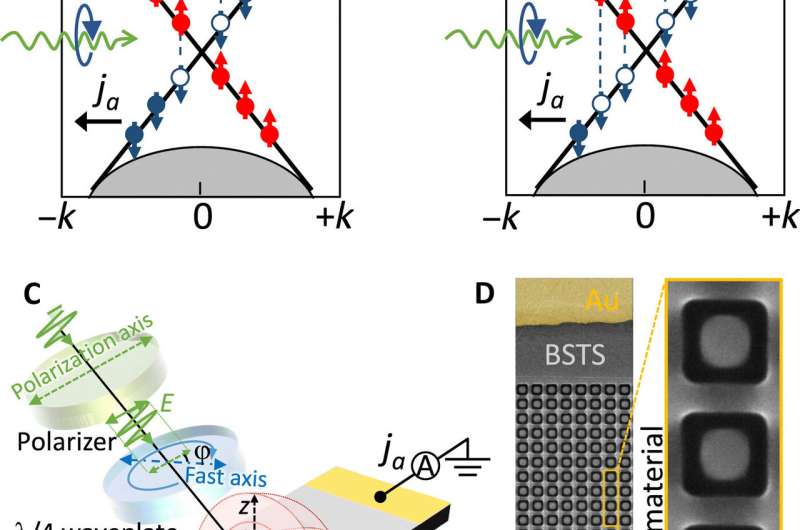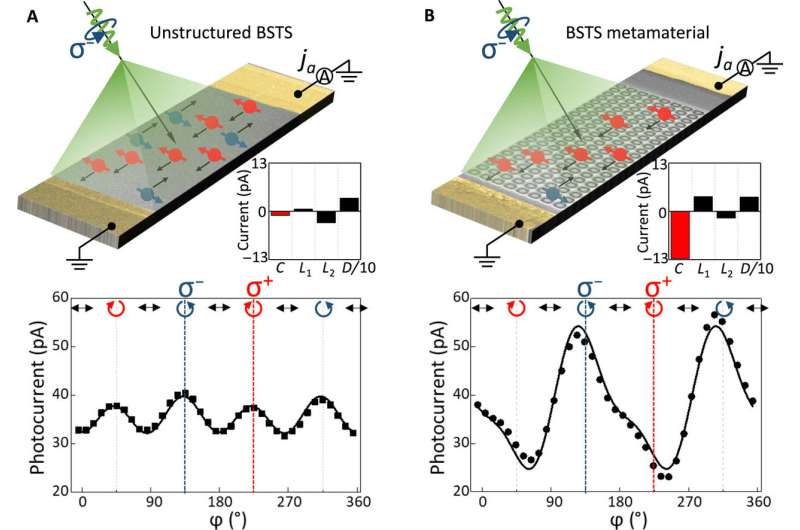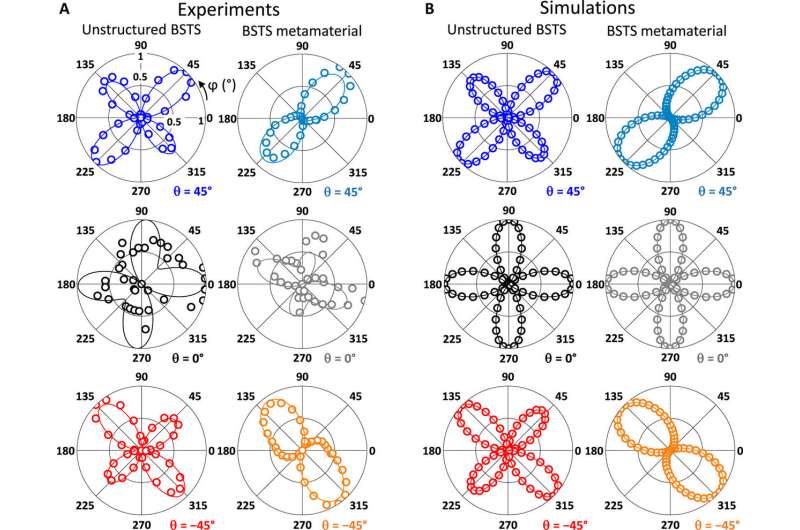Helicity-dependent photocurrent (HDPC) in topological insulators and topological insulator metamaterials. (A) In an unstructured topological insulator (TI), Dirac electrons with spin coupled to a given circular polarization of incident light (blue) are promoted to higher bands in the k-space; the excess of spin-momentum–locked surface-state electrons with opposite spin (red) gives rise to an HDPC, ja (circular photogalvanic effect). (B) In a TI metamaterial, a larger number of spin-polarized electrons are photoexcited upon resonant light absorption, enhancing the HDPC. (C) Schematic of the HDPC experimental setup, illustrating the mutual orientation of the electrodes on the TI device relative to the laser excitation beam at incidence angle θ and polarization defined by the angle of rotation φ of the quarter-wave plate. (D) SEM image of the square ring metamaterial carved between the Au electrodes on the surface of a TI flake. Scale bars, 1 μm on the left and 100 nm on the right. Credit: Science Advances, doi:10.1126/sciadv.abe5748
Topological insulators have notable manifestations of electronic properties. The helicity-dependent photocurrents in such devices are underpinned by spin momentum-locking of surface Dirac electrons that are weak and easily overshadowed by bulk contributions. In a new report now published on Science Advances, X. Sun and a research team in photonic technologies, physics and photonic metamaterials in Singapore and the U.K. showed how the chiral response of materials could be enhanced via nanostructuring. The tight confinement of electromagnetic fields in the resonant nanostructures enhanced the photoexcitation of spin-polarized surface states of a topological insulator to allow an 11-fold increase of the circular photogalvanic effect and a previously unobserved photocurrent dichroism at room temperature. Using this method, Sun et al. controlled the spin transport in topological materials via structural design, a hitherto unrecognized ability of metamaterials. The work bridges the gap between nanophotonics and spin electronics to provide opportunities to develop polarization-sensitive photodetectors.
Chirality
Chirality is a ubiquitous and fascinating natural phenomenon in nature, describing the difference of an object from its mirror image. The process manifests in a variety of scales and forms from galaxies to nanotubes and from organic molecules to inorganic compounds. Chirality can be detected at the atomic and molecular level in fundamental sciences, including chemistry, biology and crystallography, as well as in practice, such as in the food and pharmaceutical industry. To detect chirality, scientists can use interactions with electromagnetic fields, although the process can be hindered by a large mismatch between the wavelength of light and the size of most molecules at nanoscale dimensions. Designer metamaterials with structural features comparable to the wavelength of light can provide an independent approach to devise optical properties on demand to enhance the light-matter interaction to create and enhance the optical chirality of metamaterials. In this work, Sun et al. showed applications of artificial nanostructuring to improve the chiral photogalvanic response of electromagnetic fields. The resonant nonchiral metamaterials effectively improved the photoexcitation of spin-polarized states. The work showed a giant enhancement of the extrinsic chiral photocurrent response of a 3D topological insulator (TI); containing bismuth, antimony, tellurium and selenium in the following ratios: Bi1.5Sb0.5Te1.8Se1.2, abbreviated as BSTS.
Optical absorption enhancement in BSTS achiral metamaterial. (A) Measured (dashed lines) and simulated (continuous lines) optical absorption of an unstructured BSTS flake and a nanostructured BSTS metamaterial (experimental data were collected with unpolarized light at normal incidence and numerical aperture = 0.7, while simulations correspond to circularly polarized light incident at θ = 0° and θ = 45°); at λ = 532 nm, the absorption of the BSTS metamaterial is ~0.7, twice that of the unstructured BSTS flake (~0.35). (B and C) Maps of the electric field intensity, |E|2, at 10 nm below the top surface of the metamaterial unit cell at normal incidence, for left (LCP) and right (RCP) circular polarization, respectively. Credit: Science Advances, doi:10.1126/sciadv.abe5748
Sun et al. selectively excited surface-carriers in topological insulators by directing circularly polarized light at oblique incidence on the surface of the crystal. They determined the resulting current flow by spin-momentum locking at the carriers. The topological insulator crystal was intrinsically achiral, therefore photoexcitation at normal incidence did not generate any helicity-dependent photocurrent (HDPC). However, when they conducted spin-selective photoexcitation of surface-state carriers using obliquely incident light with a given helicity, they induced chirality as described for metamaterials, via the circular photogalvanic effect (CPGE). The presence of a nanostructure designed on the surface of the topological insulators indicated a resonant absorption at the wavelength of excitation to effectively increase the number of surface induction carriers, promoted to the bulk conduction bands. This process significantly increased the contribution of CPGE (circular photogalvanic effect) to the photocurrent. In the experimental setup, Sun et al. noted how the HDPC (helicity-dependent photocurrent) flowed across two gold contacts on the crystal surface without an applied bias.
Optical absorption and metamaterial design
Multifold increase of CPGE in BSTS topological insulator by metamaterials. (A) (top) Schematic of HDPC in an unstructured BSTS flake; (bottom) experimental photocurrent measured on an unstructured BSTS flake, at room temperature, and fitting with Eq. 1, showing the expected 4φ dependence and a small 2φ asymmetry between right (σ+) and left (σ−) circularly polarized illumination; (inset) fitting coefficient C, L1, L2, and D, indicating a predominance of bulk photon-drag contribution, L2, in the photocurrent modulation. (B) (top) Schematic of light HDPC in a nanostructured BSTS metamaterial; (bottom) experimental photocurrent measured on a nanostructured BSTS metamaterial, at room temperature, and fitting with Eq. 1, showing how the metamaterial induces a 2φ dependence that indicates that the sample responds almost exclusively to right (σ+) and left (σ−) circularly polarized illumination; (inset) fitting coefficient C, L1, L2, and D, indicating a predominance of CPGE, C, in the photocurrent modulation. Credit: Science Advances, doi:10.1126/sciadv.abe5748
To understand the enhancement of chirality exclusively via topological surface spin currents, Sun et al. chose a metamaterial design that did not introduce optical chirality intrinsically or extrinsically. The team selected a metamaterial unit cell with patterns carved by focused ion beam milling between two gold electrodes deposited on a flake of BSTS, which they observed using scanning electron microscopy (SEM). The metamaterial geometry did not induce any helicity dependence, which Sun et al. confirmed using maps of electric field intensity for circularly polarized light of opposite handedness. The team next controlled the circular photogalvanic effects in the topological insulator using the metamaterial. They measured the HDPC (helicity-dependent photocurrent) under nearly uniform illumination without an applied bias. The setup resulted in polarization-independent photothermoelectric currents which contributed to the photocurrent background. The component of the current was also sensitive to the position of the excitation beam on the sample.
Photocurrent signal
To measure clear photocurrent signals, Sun et al. next adjusted the laser beam position on the BSTS flake and BSTS metamaterial to obtain the maximum photocurrent. The scientists noted how the surface contributions to the photocurrents were discernible even at room temperature in unstructured BSTS samples, while bulk components overshadowed their dependence on light helicity, while being too small for any practical device or application. When the team patterned the BSTS flake with a square ring metamaterial array, it behaved markedly differently. The resonant metamaterial structure induced larger asymmetry relative to surface conducting bands to increase the net spin current. The team defined the photocurrent circular dichroism induced by spin-polarized surface states and confirmed the surface nature of HDPC in BSTS. The outcomes of the study showed how the metamaterials did not introduce chirality but enhanced the extrinsic chirality of the BSTS surface layer.
Distillation of CPGE in BSTS topological insulator flakes by nanostructured metamaterials. (A) Normalized polar plots of HDPC for an unstructured BSTS flake (left column) and a nanostructured BSTS metamaterial (right column) at three different angles of incidence, θ = 45° (top row), θ = 0° (center row), and θ = −45° (bottom row); at θ = 0°, mostly L2 contributes to the modulation of the photocurrent; at θ = 45° and θ = −45, the HDPC patterns of the unstructured BSTS flake and the BSTS metamaterial are distinctively different: The metamaterial distils the C term contribution to the photocurrent modulation, with respect to the unstructured BSTS flake, where L1, L2, and C have comparable amplitudes. (B) Simulated |E|2 in both unstructured 250-nm BSTS film (left column) and nanostructured BSTS metamaterial (right column) at three different angles of incidence, θ = 45° (top row), θ = 0° (center row), and θ = −45° (bottom row), with artificially increased chirality of the optical permittivity, εr, of the BSTS; the distinct behavior observed in the unstructured BSTS and the BSTS metamaterial matches remarkably well with the measured photocurrent, indicating how the chirality of the surface carriers and the increased absorption given by the metamaterial result in a giant increase of the CPGE; the |E|2 is integrated in a 3-nm-thin slab at the surface of the film. To better visualize the polarization (φ) dependence of both experimental data and numerical model, we subtract the polarization independent background from each curve and normalize them. Credit: Science Advances, doi:10.1126/sciadv.abe5748
Electromagnetic modeling
Sun et al. then discussed the photocurrent behavior of spin-transport metamaterials via electromagnetic modeling. The generated photocurrent was directly proportional to the optical absorption, carrier density, mobility and lifetime of the topological insulator. Based on the assumption that the optical absorption of the BSTS metamaterial increased upon nanostructuring while the transport parameters remained unaltered, Sun et al. mapped the carrier anisotropic optical model of the BSTS topological insulator crystal. The scientists performed full-wave electromagnetic simulations for unstructured and nanostructured BSTS, by replicating the sample illumination conditions used in the experiments, to understand the optical absorption at the surface of the topological insulator. The electromagnetic modeling agreed well with the experimental HDPC results.
Outlook
In this way, X. Sun and colleagues provided a method to use metamaterials to control surface transport in topological insulators via structural design. This method provides a powerful toolbox to bridge the gap between nanophotonics and spin electronics. The team showed how resonant nanostructures induced giant enhancement of the extrinsic chiral photocurrent response of a topological insulator. The outcomes can be explored to exert control on spin transport properties of other classes of quantum and topological materials.
More information: Sun X et al. Topological insulator metamaterial with giant circular photogalvanic effect, Science Advances, 10.1126/sciadv.abe5748
Hsieh D. et al. A tunable topological insulator in the spin helical Dirac transport regime. Nature, doi.org/10.1038/nature08234
Ma Q. et al. Direct optical detection of Weyl fermion chirality in a topological semimetal, Nature Physics, doi.org/10.1038/nphys414
Journal information: Nature , Science Advances , Nature Physics
© 2021 Science X Network


























